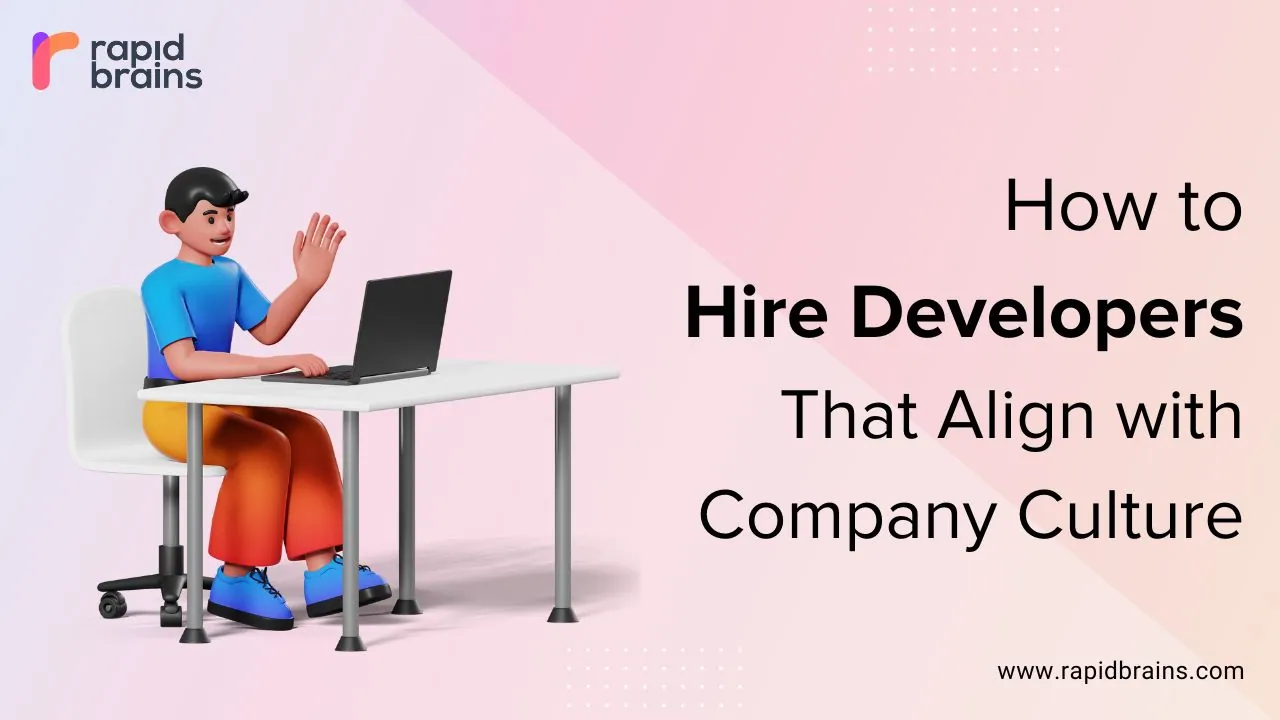
Company culture plays a pivotal role in the success of any organization. It encompasses the values, beliefs, and principles that guide how employees interact, make decisions, and contribute to the company’s goals.
According to a study by Deloitte, 94% of executives and 88% of employees believe that a distinct workplace culture is essential for business success. A strong company culture can lead to increased employee engagement, satisfaction, and retention, directly impacting an organization’s bottom line.
Significance of hiring developers who align with company culture
When hiring developers, it’s crucial to consider not only their technical skills but also their alignment with the company culture. Developers who fit well within the organizational culture are more likely to be engaged, productive, and committed to the company’s long-term success.
A survey by Glassdoor found that 67% of job seekers consider company culture an essential factor when evaluating job offers.
Moreover, research by the Society for Human Resource Management (SHRM) indicates that the cost of a bad cultural fit can range from 50% to 60% of an employee’s annual salary due to lost productivity, lower morale, and increased turnover.
I. Start With Defining Company Culture
A. Core values, beliefs, and principles
Company culture is rooted in the core values, beliefs, and principles that guide an organization’s decision-making and interactions. These foundational elements shape how employees work together, approach problem-solving, and contribute to the company’s mission. For example, Google’s company culture emphasizes innovation, collaboration, and risk-taking, which has helped it become a leader in the technology industry. By defining your organization’s core values and aligning them with your business objectives, you create a solid foundation for a thriving company culture.
B. Work environment and expectations
The work environment and expectations also play a significant role in defining company culture. This includes factors such as work-life balance, flexibility, remote work policies, and performance expectations. For instance, a company like Basecamp, which prioritizes work-life balance and offers a 32-hour workweek during the summer months, has a culture that values employee well-being and personal growth.
| A study by Stanford University found that work-life balance and flexible work arrangements can lead to a 13% increase in productivity and a 50% decrease in employee attrition rates. |
C. Communication styles and collaboration
Effective communication and collaboration are essential components of a strong company culture. Organizations need to establish communication styles and channels that promote transparency, inclusivity, and teamwork.
For example, Zappos, an online shoe retailer known for its unique company culture, encourages open communication and cross-functional collaboration to drive innovation and customer satisfaction. According to Pumble, companies with effective communication practices are 4.5 times more likely to outperform their peers in terms of revenue growth.
By fostering a culture of open communication and collaboration, organizations can create an environment where employees feel valued, engaged, and motivated to contribute to the company’s success.
II. Identifying Key Cultural Traits for Developers
A. Technical skills and expertise
Developers must possess the necessary technical skills and expertise to contribute effectively to software projects. Identifying the specific technologies, languages, and frameworks relevant to your organization is crucial in finding developers who can hit the ground running.
According to the Stack Overflow Developer Survey, the top three most popular programming languages in 2021 were JavaScript, HTML/CSS, and SQL. Hiring developers with the right technical skills helps ensure that they can seamlessly integrate into your team and contribute to the company’s success.
B. Adaptability and continuous learning
The technology industry is continuously evolving, making adaptability and a commitment to continuous learning essential traits for developers. A survey by the World Economic Forum found that 54% of employees would need significant reskilling and upskilling by 2022 due to rapid advancements in technology.
Hiring developers who embrace change, stay updated on the latest trends, and actively develop their skills can help your organization maintain a competitive edge in the market.
C. Teamwork and collaboration
Software development is often a collaborative process that requires developers to work effectively with cross-functional teams. According to a study by Google’s Project Aristotle, psychological safety, which is the ability to openly share ideas and collaborate without fear of negative consequences, was the most critical factor in high-performing teams.
Identifying developers who value teamwork and can collaborate effectively with others is vital for fostering a positive work environment and driving project success.
D. Problem-solving and critical thinking
Developers must be able to analyze complex problems, think critically, and develop innovative solutions. A study by the World Economic Forum ranked complex problem-solving and critical thinking among the top three skills needed for the future workforce.
By hiring developers who possess strong problem-solving and critical-thinking abilities, you can ensure that your team can tackle challenges and deliver high-quality software products.
E. Communication skills
Effective communication is essential for developers to understand project requirements, share ideas, and collaborate with their team members. A study by the Harvard Business Review found that poor communication cost companies with 100 employees an average of $420,000 per year.
Hiring developers with strong communication skills can help reduce misunderstandings, improve collaboration, and ultimately contribute to the success of your software projects.
III. Sourcing Candidates Who Align with Company Culture
A. Job postings and descriptions
- Emphasizing cultural fit
When creating job postings and descriptions, it is crucial to emphasize the cultural fit alongside the technical requirements. By clearly outlining your company’s values, mission, and work environment, you can attract candidates who share similar beliefs and principles. A study by Glassdoor found that 69% of job seekers are likely to apply to a job if the employer actively manages its employer brand, which includes sharing company culture and values.
- Highlighting company values and expectations
In job postings, highlight your company’s values and expectations to give candidates an accurate representation of your organizational culture. This transparency helps candidates self-select based on their alignment with your culture, increasing the likelihood of finding a good fit. A LinkedIn survey revealed that 72% of recruiting leaders believe that employer branding has a significant impact on hiring.
B. Leveraging professional networks and referrals
Referrals from existing employees and professional networks can be an excellent source of candidates who align with your company culture. Employees are more likely to refer candidates who they believe will fit well within the organization.
According to a study by Jobvite, employee referrals lead to faster hires (55% faster than career sites), and referred employees have a 45% retention rate after two years compared to 20% from job boards.
C. Utilizing social media and online platforms
- LinkedIn and other professional networking sites
Social media platforms like LinkedIn can be invaluable in sourcing candidates who align with your company culture. By sharing content that showcases your culture and values, you can attract potential candidates who resonate with your organization.
| LinkedIn data shows that organizations with strong employer brands see a 50% reduction in cost per hire and a 28% decrease in employee turnover. |
- Industry-specific forums and communities
Industry-specific forums and communities, such as GitHub for developers or Dribbble for designers, can also be excellent sources for finding culturally aligned candidates. These platforms allow you to engage with potential candidates, gain insights into their work, and assess their compatibility with your company’s values and work style.
IV. Assessing Cultural Fit During the Interview Process
A. Structured interview questions
- Behavioral questions to gauge alignment with company values
Behavioral interview questions can help assess a candidate’s cultural fit by examining their past experiences and how they align with the company’s values. Research shows that behavioral interviews are 2.5 times more effective at predicting job performance than traditional interviews. Asking questions about how candidates have demonstrated your company’s core values in past situations can provide valuable insights into their compatibility with your culture.
- Scenario-based questions to evaluate problem-solving and collaboration
Scenario-based questions can help assess a candidate’s problem-solving and collaboration skills, which are essential for working effectively in a team-oriented environment. These questions often present hypothetical situations related to the job and ask candidates to describe how they would approach and resolve the issue. This can help you determine if their problem-solving style and approach to teamwork align with your company culture.
B. Incorporating team members in the interview process
Involving team members in the interview process can provide multiple perspectives on a candidate’s cultural fit. According to a study by the Harvard Business Review, a panel interview approach can help reduce biases and improve hiring decisions. Including team members can also help assess how well the candidate interacts with potential colleagues, contributing to a more accurate evaluation of their fit within the organization.
C. Assessing candidates’ reactions to company culture
- Observing body language and non-verbal cues
Paying attention to a candidate’s body language and non-verbal cues during the interview can help you gauge their level of comfort and alignment with your company culture. For example, if a candidate seems engaged, enthusiastic, and open to discussing the company’s values, this can indicate a strong cultural fit.
- Analysing their questions and concerns
Candidates’ questions and concerns during the interview can also provide insights into their fit with your company culture. If they express genuine interest in understanding the organization’s values, work environment, and expectations, it can signal that they are actively considering their compatibility with your culture. Encouraging open dialogue during the interview process can help both parties assess the potential for a successful long-term working relationship.
V. Evaluating Technical Skills and Cultural Fit
A. Technical assessments and coding challenges
Technical assessments and coding challenges can help evaluate a candidate’s skills and expertise in specific programming languages, frameworks, or technologies. According to a study by HackerRank, 88% of hiring managers believe that these assessments are essential for evaluating developers’ technical skills.
By incorporating technical assessments into the hiring process, you can ensure that candidates have the necessary skills to succeed in their role while also assessing how they approach problem-solving and work under pressure, which can provide insights into their cultural fit.
B. Collaborative projects or pair programming
Involving candidates in collaborative projects or pair programming exercises can help assess their technical skills and cultural fit simultaneously. These exercises can reveal how well candidates communicate, collaborate, and contribute to the team’s goals.
A study by the Harvard Business Review found that companies using work sample tests, which include collaborative projects and pair programming exercises, have a 29% higher success rate in hiring.
By observing candidates in real-world working scenarios, you can better understand their compatibility with your company’s culture and development practices.
C. Trial periods or probationary employment
Trial periods or probationary employment can be an effective way to evaluate a candidate’s technical skills and cultural fit before making a long-term commitment. During this period, both the employer and employee can assess whether the working relationship is mutually beneficial and aligned with the company’s culture. A study by the Society for Human Resource Management (SHRM) found that 69% of companies use probationary periods to evaluate new hires. This approach allows organizations to make more informed hiring decisions and reduce the risk of turnover due to cultural misalignment.
VII. Maintaining and Strengthening Company Culture
A. Regular feedback and performance evaluations
Regular feedback and performance evaluations are essential for maintaining and strengthening company culture. They help ensure that employees remain aligned with the organization’s values and expectations, and they provide opportunities for growth and improvement.
According to a Gallup study, employees who receive regular feedback and recognition are more engaged, and their productivity increases by up to 12.5%. By investing in continuous performance management, you can foster a culture of growth, development, and accountability.
B. Open communication channels and transparent decision-making
Open communication channels and transparent decision-making contribute to a strong company culture by promoting trust, inclusivity, and collaboration. A study by the Harvard Business Review found that transparency in decision-making ranked as one of the top factors for creating high employee satisfaction.
By fostering open communication and involving employees in decision-making processes, you can create an environment where everyone feels valued and engaged, ultimately strengthening the company culture.
C. Investing in employee growth and development
Supporting employee growth and development not only improves individual performance but also strengthens company culture. According to a LinkedIn Learning report, 94% of employees would stay at a company longer if it invested in their career development.
By offering professional development opportunities such as training programs, workshops, and mentorship, you can demonstrate your commitment to employee growth and foster a culture that values continuous learning.
D. Fostering a culture of recognition and appreciation
Recognizing and appreciating employees’ contributions is crucial for maintaining and strengthening company culture. A study by Deloitte found that companies with strong recognition programs have a 31% lower voluntary turnover rate than those with weak programs.
By acknowledging employees’ efforts and accomplishments, you can create a positive work environment where individuals feel motivated to perform their best and contribute to the organization’s success. This, in turn, reinforces your company culture and helps attract and retain top talent.
Conclusion
In conclusion, hiring developers who align with your company culture is critical for the success of your organization. By defining your company culture, identifying key cultural traits, sourcing candidates who resonate with your values, and assessing their fit during the interview process, you can build a team of developers that contribute effectively to your projects and strengthen your overall company culture.
Investing in employee growth, fostering open communication, and recognizing employees’ contributions will not only maintain but also strengthen your company culture, leading to higher employee satisfaction, productivity, and retention.




